Solar eclipse of October 23, 2014
| Solar eclipse of October 23, 2014 | |
|---|---|
 Map | |
| Type of eclipse | |
| Nature | Partial |
| Gamma | 1.0908 |
| Magnitude | 0.8114 |
| Maximum eclipse | |
| Coordinates | 71°12′N 97°12′W / 71.2°N 97.2°W |
| Times (UTC) | |
| (P1) Partial begin | 19:37:30 |
| Greatest eclipse | 21:45:39 |
| (P4) Partial end | 23:51:36 |
| References | |
| Saros | 153 (9 of 70) |
| Catalog # (SE5000) | 9540 |
A partial solar eclipse occurred on October 23, 2014. A solar eclipse occurs when the Moon passes between Earth and the Sun, thereby totally or partly obscuring the image of the Sun for a viewer on Earth. A partial solar eclipse occurs in the polar regions of the Earth when the center of the Moon's shadow misses the Earth.
Viewing
The center of the Moon's shadow missed the Earth, passing above the North Pole, but a partial eclipse was visible at sunrise (October 24 local time) in far eastern Russia and Japan, and before sunset (October 23) across most of North America.
 Animated path |
Visibility
The partial eclipse was visible in most of North America.
Gallery
| Wikimedia Commons has media related to Solar eclipse of 2014 October 23. |

 Partial solar eclipse October 23, 2014 at 21:25:57 UTC from San Jose, California.
Partial solar eclipse October 23, 2014 at 21:25:57 UTC from San Jose, California.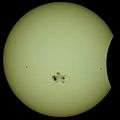 Minneapolis, Minnesota, 21:34 UTC. The eclipse coincided with giant sunspot region 2192, the largest seen in 24 years.[1]
Minneapolis, Minnesota, 21:34 UTC. The eclipse coincided with giant sunspot region 2192, the largest seen in 24 years.[1] Minneapolis, Minnesota, 22:35:23 UTC, wide angle, 30 minutes before sunset
Minneapolis, Minnesota, 22:35:23 UTC, wide angle, 30 minutes before sunset Minneapolis, Minnesota, 22:36 UTC, greatest eclipse
Minneapolis, Minnesota, 22:36 UTC, greatest eclipse Minneapolis, Minnesota, 22:54:12 UTC, 11 minutes before sunset
Minneapolis, Minnesota, 22:54:12 UTC, 11 minutes before sunset Partial solar eclipse, Coralville, Iowa, 22:55:58 UTC
Partial solar eclipse, Coralville, Iowa, 22:55:58 UTC Minneapolis, Minnesota, time lapse images
Minneapolis, Minnesota, time lapse images
Related eclipses
Solar eclipses 2011–2014
Each member in a semester series of solar eclipses repeats approximately every 177 days and 4 hours (a semester) at alternating nodes of the Moon's orbit. Note: Partial solar eclipses on January 4, 2011, and July 1, 2011, occur in the previous semester series.
| Solar eclipse series sets from 2011–14 | ||||
|---|---|---|---|---|
| Descending node | Ascending node | |||
| Saros | Map | Saros | Map | |
| 118 | June 1, 2011 Partial |
123 | November 25, 2011 Partial | |
128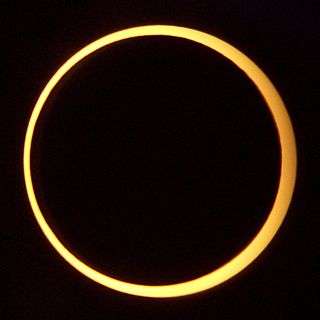 Middlegate, Nevada |
May 20, 2012 Annular |
133 Ellis Beach, Queensland |
November 13, 2012 Total | |
| 138 Churchills Head, Australia |
May 10, 2013 Annular |
143 Partial from Accra, Ghana |
November 3, 2013 Hybrid | |
| 148 | April 29, 2014 Annular |
153 Partial from Minneapolis |
October 23, 2014 Partial | |
Metonic series
The metonic series repeats eclipses every 19 years (6939.69 days), lasting about 5 cycles. Eclipses occur in nearly the same calendar date. In addition the octon subseries repeats 1/5 of that or every 3.8 years (1387.94 days).
| 21 eclipse events between August 12, 1942 and August 11, 2018 | ||||
|---|---|---|---|---|
| August 10-12 | May 30 | March 18 | January 4-5 | October 23-24 |
| 115 | 117 | 119 | 121 | 123 |
 August 12, 1942 |
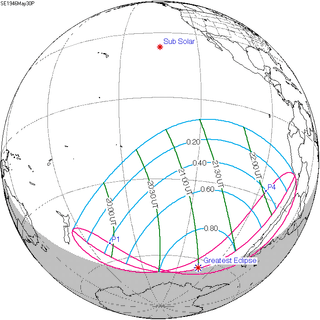 May 30, 1946 |
 March 18, 1950 |
 January 5, 1954 |
 October 23, 1957 |
| 125 | 127 | 129 | 131 | 133 |
 August 11, 1961 |
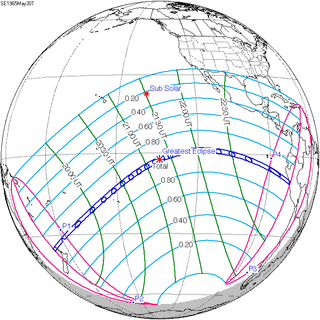 May 30, 1965 |
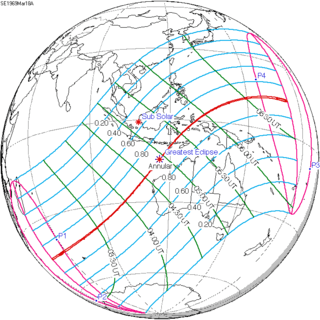 March 18, 1969 |
 January 4, 1973 |
 October 23, 1976 |
| 135 | 137 | 139 | 141 | 143 |
 August 10, 1980 |
 May 30, 1984 |
 March 18, 1988 |
 January 4, 1992 |
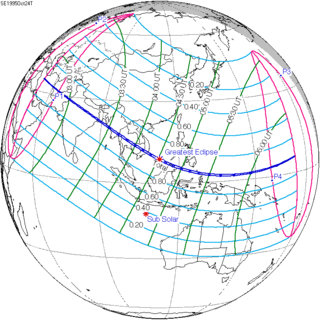 October 24, 1995 |
| 145 | 147 | 149 | 151 | 153 |
 August 11, 1999 |
 May 31, 2003 |
 March 19, 2007 |
 January 4, 2011 |
 October 23, 2014 |
| 155 | ||||
 August 11, 2018 | ||||
References
| Wikimedia Commons has media related to Solar eclipse of 2014 October 23. |
External links
- Earth visibility chart and eclipse statistics Eclipse Predictions by Fred Espenak, NASA/GSFC
- Partial Solar Eclipse 23 October 2014 from start to maximum on YouTube
- Nontechnical information at NASA SSERVI
- Sunspots and Solar Eclipse APOD 10/25/2014